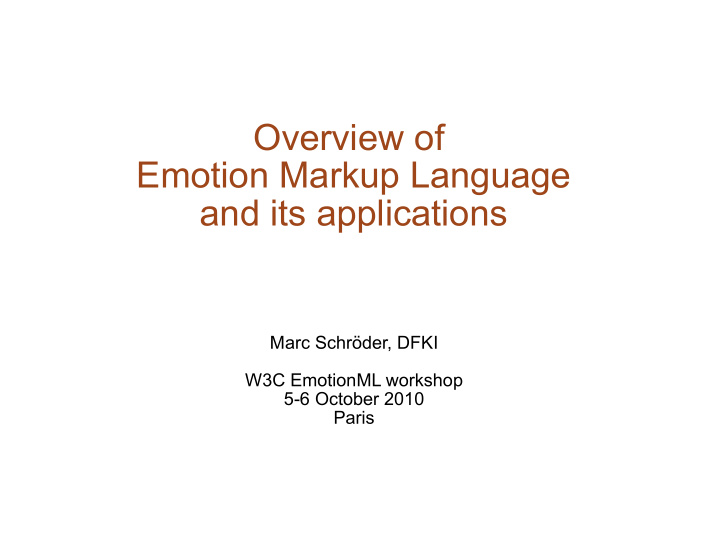



Overview of Emotion Markup Language and its applications Marc Schröder, DFKI W3C EmotionML workshop 5-6 October 2010 Paris
Emotion Markup Language (from the MMI Charter:) EmotionML will provide representations of emotions and related states for technological applications EmotionML will serve as a "plug-in" language suitable for use in three different areas (1) manual annotation of data; (2) automatic recognition of emotion-related states from user behavior; and (3) generation of emotion-related system behavior. The W3C Emotion Markup Language 2
Envisaged application areas (1) Opinion mining / sentiment analysis in Web 2.0 automatically track customer's attitude regarding a product across blogs Affective monitoring ambient assisted living applications for the elderly fear detection for surveillance purposes using wearable sensors to test customer satisfaction Character design and control for games and virtual worlds Social robots such as guide robots engaging with visitors The W3C Emotion Markup Language 3
Envisaged application areas (2) Expressive speech synthesis generating synthetic speech with different emotions, such as happy or sad, friendly or apologetic Emotion recognition e.g., for spotting angry customers in speech dialog systems Support for people with disabilities such as educational programs for people with autism All these applications exist today some are on the market others still in research labs The W3C Emotion Markup Language 4
EmotionML: Basic idea Since there is no single agreed emotion representation even in science, we must give our users a choice EmotionML provides support for representing different facets of emotions – categories – dimensions – appraisals – action tendencies EmotionML gives users a choice of emotion vocabularies – centrally defined “recommended” vocabularies – user-defined custom vocabularies The W3C Emotion Markup Language 5
EmotionML: Brief history 2006-2008: Two Incubator groups laid the foundations Emotion XG (use cases, requirements) Emotion Markup Language XG (markup) 2009-present: Work towards a formal W3C Recommendation in the Multimodal WG First Public Working Draft published on 29 October 2009 – minor modifications from previous Final Incubator Report of EmotionML XG – trend towards simplification and ease of use Second Working Draft published on 29 July 2010 – preliminary list of emotion vocabularies – syntax aligned with W3C customs The W3C Emotion Markup Language 6
EmotionML: Members involved People active in the MMI EmotionML subgroup: DFKI (Marc Schröder) Loquendo (Paolo Baggia, Enrico Zovato) Deutsche Telekom (Felix Burkhardt) Fraunhofer (Christian Peter) Institut Telecom (Catherine Pelachaud) CNR (Alessandro Oltramari) NICTA (Rafael Calvo) The W3C Emotion Markup Language 7
EmotionML syntax (1) Representations of emotions A single statement about an emotion is represented by: <emotion> ... </emotion> The W3C Emotion Markup Language 8
EmotionML syntax (1) Representations of emotions Emotion categories <emotion> <category name="satisfaction"/> </emotion> but what do we mean by “satisfaction”? emotion words can mean very different things in different contexts, e.g. “anger” so we make explicit from which vocabulary we take the descriptor The W3C Emotion Markup Language 9
EmotionML syntax (1) Representations of emotions Emotion categories <emotion category-set="http://www.example.com/emotion/category/everyday-emotions.xml" category-set="http://www.example.com/emotion/category/everyday-emotions.xml"> <category name="satisfaction"/> </emotion> but what do we mean by “satisfaction”? emotion words can mean very different things in different contexts, e.g. “anger” so we make explicit from which vocabulary we take the descriptor The W3C Emotion Markup Language 10
EmotionML syntax (1) Representations of emotions Emotion dimensions, appraisals and action tendencies name scale values in range [0, 1] <emotion> <dimension name="arousal" value="0.3"/> <dimension name="pleasure" value="0.9"/> <dimension name="dominance" value="0.8"/> </emotion> <emotion> <appraisal name="novelty" value="0.8"/> <appraisal name="intrinsic-pleasantness" value="0.2"/> </emotion> <emotion> <action-tendency name="approach" value="0.7"/> <action-tendency name="avoid" value="0.0"/> <action-tendency name="attending" value="0.7"/> </emotion> The W3C Emotion Markup Language 11
EmotionML syntax (1) Representations of emotions Emotion dimensions, appraisals and action tendencies same principle: identify vocabulary used for descriptors <emotion dimension-set="http://www.example.com/emotion/dimension/PAD.xml" dimension-set="http://www.example.com/emotion/dimension/PAD.xml"> <dimension name="arousal" value="0.3"/> <dimension name="pleasure" value="0.9"/> <dimension name="dominance" value="0.8"/> </emotion> <emotion appraisal-set="http://www.example.com/emotion/appraisal/scherer.xml" appraisal-set="http://www.example.com/emotion/appraisal/scherer.xml"> <appraisal name="novelty" value="0.8"/> <appraisal name="intrinsic-pleasantness" value="0.2"/> </emotion> <emotion action-tendency-set="http://www.example.com/emotion/action/frijda.xml" action-tendency-set="http://www.example.com/emotion/action/frijda.xml"> <action-tendency name="approach" value="0.7"/> <action-tendency name="avoid" value="0.0"/> <action-tendency name="attending" value="0.7"/> </emotion> The W3C Emotion Markup Language 12
EmotionML syntax (1) Representations of emotions Emotion representations can be combined into one tag as long as they describe various facets of the same emotion: <emotion category-set="http://www.example.com/emotion/category/everyday-emotions.xml dimension-set="http://www.example.com/emotion/dimension/PAD.xml" appraisal-set="http://www.example.com/emotion/appraisal/scherer.xml" action-tendency-set="http://www.example.com/emotion/action/frijda.xml"> <category name="satisfaction"/> <dimension name="arousal" value="0.3"/> <dimension name="pleasure" value="0.9"/> <dimension name="dominance" value="0.8"/> <appraisal name="novelty" value="0.3"/> <appraisal name="intrinsic-pleasantness" value="0.9"/> <action-tendency name="approach" value="0.7"/> <action-tendency name="avoid" value="0.0"/> <action-tendency name="attending" value="0.4"/> </emotion> The W3C Emotion Markup Language 13
EmotionML syntax (2) Vocabularies for representing emotions Preliminary list from scientific literature One aim of this workshop: Feedback on our selection – what did we forget? – what is inappropriate/incomplete/redundant/...? The W3C Emotion Markup Language 14
EmotionML syntax (2) Vocabularies for representing emotions Category vocabularies Ekman's "big six" basic emotions (6) – anger disgust fear happiness sadness surprise Cowie et al. (1999)'s Everyday emotion vocabulary (17) – affectionate afraid amused angry bored confident content disappointed excited happy interested loving pleased relaxed sad satisfied worried OCC categories (Ortony et al., 1988) (22) – admiration anger disappointment distress fear fears-confirmed gloating gratification gratitude happy-for hate hope joy love pity pride relief remorse reproach resentment satisfaction shame “FSRE” categories (Fontaine et al., 2007) (24) – anger anxiety being-hurt compassion contempt contentment despair disappointment disgust fear guilt happiness hate interest irritation jealousy joy love pleasure pride sadness shame stress surprise Frijda (1986)'s categories (12) – anger arrogance desire disgust enjoyment fear humility indifference interest resignation shock surprise The W3C Emotion Markup Language 15
EmotionML syntax (2) Vocabularies for representing emotions Dimension vocabularies Mehrabian (1996)'s PAD dimensions – pleasure arousal dominance FSRE dimensions (Fontaine et al., 2007) – valence potency arousal unpredictability The W3C Emotion Markup Language 16
Recommend
More recommend